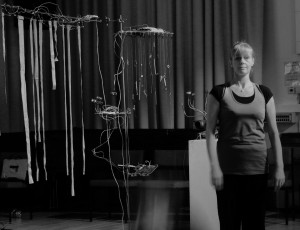http://rhoadley.net/comp/only_connect.php
http://rhoadley.org/sounds/only_connect/only_connect.mp3
Only Connect was originally written for the Durham University Chamber Orchestra. The title is the epigram of E.M.Forster’s book Howards End, but if a work of Forster’s could be said to influence the piece at all it would be A Passage to India, in which links are attempted between diverse peoples and the individuals’ relationship to the whole. However, the title was not decided upon until well into the composition of the piece, and so neither book played any part in its conception.
One of the original ideas was for a series of fugues for orchestra and a number of solo instruments, (basically, the principals of each instrument (flute/piccolo, oboe, clarinet, bassoon, trumpet, violin, hence the solo violin). Although a set of instrumental soli remain, the element of fugue has gone.
Another early idea that remains in the present score. This came from hearing a radio broadcast of Vaclav Havel’s play Largo Desolato in the translation by Tom Stoppard. The play has many features which can be related to music, quite possibly consciously, and these features give the play an unreal air, rather as if the characters were actually performing a slow, tragicomic dance. Blocks of text repeat, slightly altered in differing circumstances, rather in the way that block type music is composed. One feels that when these blocks recur one is sliding into a nightmarish spiral from which escape is impossible.
The aspect of the play’s performance which influenced Only Connect is a structural device. Each of the seven scenes of the play are separated by a short musical interlude, the music being defined in the text only as ‘impressive orchestral music’. In fact, the first three scenes comprise only the following actions:
SCENE ONE
As the music dies away the curtain rises slowly.
LEOPOLD is alone on the stage. He is sitting on the sofa and staring at the front door. After a long pause he gets up and looks through the peep-hole. Then he puts his ear to the door and listens intently. After another long pause the curtain drops suddenly and at the same time the music returns.
SCENE TWO
As the music dies away the curtain rises slowly.
LEOPOLD is alone on the stage. He is sitting on the sofa and staring at the front door. After a long pause he gets up and looks through the peep-hole. Then he puts his ear to the door and listens intently. After another long pause the curtain drops suddenly and at the same time the music returns.
SCENE THREE
As the music dies away the curtain rises slowly.
LEOPOLD is alone on the stage. He is sitting on the sofa and staring at the front door. After a long pause he gets up and looks through the peep-hole. Then he puts his ear to the door and listens intently. He evidently hears something which makes him jump back…
This seemed an extraordinarily effective and uniquely powerful opening, given suitable music. The contrast between the ‘impressive music’ (as I ‘heard’ it – not the music used during the broadcast), and the silence with the nervous reactions of the isolated figure, in addition to the dramatic action of the curtain, formally isolating the figure seemed an excellent way of opening a piece and giving a powerful image and reference point. Finally, it also shared with a number of my pieces the same form of three similar gestures alternating with a contrasting idea.

